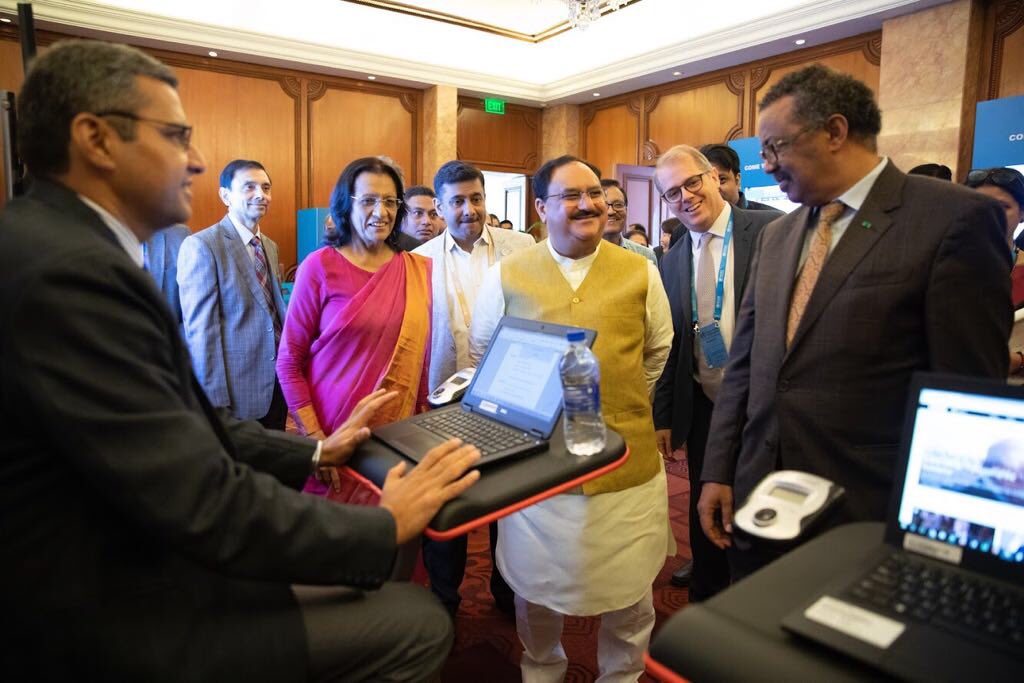In what is said to be a feather in the crown of the Modi government, the Director General of the World Health Organization (WHO) Mr Tedros Adhanom Ghebreyesus has praised Prime Minister Narendra Modi’s Ayushman Bharat initiative which aims to provide insurance cover of Rs five lakh per annum to 50 crore people, by saying “Very impressed”.
Mr Tedros Adhanom Ghebreyesus tweeted “Very impressed with India’s initiative on Ayushman Bharat or universal Health Coverage! Thank you Prime Minister Narendra Modi. Great commitment! Thank you Indian Minister of Health, JP Nadda, for meeting me today!” and praised the flagship programme of the Modi government.


The Union Minister of Health and Family Welfare Mr Jagat Prakash Nadda responded to this saying “Thank you for your kind words Tedros Adhanom Ghebreyesus and a very fruitful meeting. Our PM envisions to make healthcare accessible and affordable for all. Under PMJAY, an insurance cover of Rs 5 lakh will be extended to 50 Cr people- equal the size of the population of America, Canada, Mexico”.

Ayushman Bharat is National Health Protection Scheme which will cover over 10 crore poor and vulnerable families (approximately 50 crore beneficiaries) providing coverage upto 5 lakh rupees per family per year for secondary and tertiary care hospitalization.
Earlier PM Modi had said “It is essential to ensure that we free the poor of India from the clutches of poverty due to which they cannot afford healthcare. It is high time we ensure that the poor of India get access to good quality and affordable healthcare”
Here are the salient features of Ayushman Bharat stated by the Indian Government:
- Ayushman Bharat – National Health Protection Mission will have a defined benefit cover of Rs. 5 lakh per family per year.
- Benefits of the scheme are portable across the country and a beneficiary covered under the scheme will be allowed to take cashless benefits from any public/private empanelled hospitals across the country.
- Ayushman Bharat – National Health Protection Mission will be an entitlement based scheme with entitlement decided on the basis of deprivation criteria in the SECC database.
- The beneficiaries can avail benefits in both public and empanelled private facilities.
- To control costs, the payments for treatment will be done on package rate (to be defined by the Government in advance) basis.
- One of the core principles of Ayushman Bharat – National Health Protection Mission is to co-operative federalism and flexibility to states.
- To ensure that the funds reach SHA on time, the transfer of funds from Central Government through Ayushman Bharat – National Health Protection Mission to State Health Agencies may be done through an escrow account directly.
- In partnership with NITI Aayog, a robust, modular, scalable and interoperable IT platform will be made operational which will entail a paperless, cashless transaction.

How many Indians will be benefited by Ayushman Bharat scheme and who will fund the scheme?
As per the reports, PM Modi’s Ayushman Bharat scheme would target about 10.74 crore poor, deprived rural families and identified occupational category of urban workers’ families as per the latest Socio-Economic Caste Census (SECC) data covering both rural and urban.
The government has also stated that the expenditure incurred in premium payment will be shared between Central and State Governments in specified ratio as per Ministry of Finance guidelines in vogue.
What are the strategies of Modi government to implement this scheme?
- At the national level to manage, an Ayushman Bharat National Health Protection Mission Agency (AB-NHPMA) would be put in place. States/ UTs would be advised to implement the scheme by a dedicated entity called State Health Agency (SHA). They can either use an existing Trust/ Society/ Not for Profit Company/ State Nodal Agency (SNA) or set up a new entity to implement the scheme.
- States/ UTs can decide to implement the scheme through an insurance company or directly through the Trust/ Society or use an integrated model.
Source: Swarajyamag.com






No comments:
Post a Comment